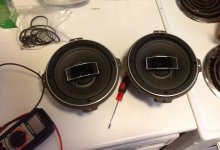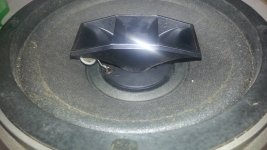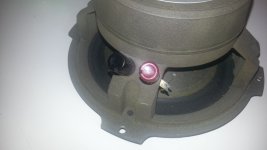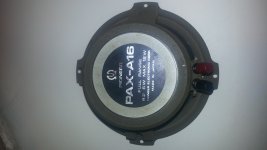I may have mentioned these here, and if so, apologize... I have a pair of Pioneer PAX-A16 drivers I would like to use, but one has a tweeter that is not working. How can I ascertain whether or not the tweeter is salvageable? The one that doesn't work has a really off ohm reading, while the other is about 9.2ohm. Any help is appreciated.
Attachments
Thanks Cal.
Any suggestions where to start? All I see is a capacitor in the tweeters signal path. There are three contacts visible under the tweeter lens. Two appear to be directly connected to the woofer. One terminal is shared with the tweeter it appears via the capacitor. I've tried to test two terminals there but cannot discern if they are the correct ones to be testing.
Any suggestions where to start? All I see is a capacitor in the tweeters signal path. There are three contacts visible under the tweeter lens. Two appear to be directly connected to the woofer. One terminal is shared with the tweeter it appears via the capacitor. I've tried to test two terminals there but cannot discern if they are the correct ones to be testing.
And a screwdriver. This may involve removing parts. If I'm seeing it right, you have tinsel leads coming through the cane to the HF driver? Not the best way of doing it but are we to suppose this is a little tweeter mounted inside the cone rather than the more common comp driver mounted on the rear of the woofer magnet?
I think we have the same oven.
I think we have the same oven.
I think we have the same oven.
Is it super narrow and wont fit any large pans? Haha
Chris is right... photos would help.
Im not quite sure how to remove the tweeter lens or the price behind it. The screws are obstructed by the lens.
Attachments
I'm sure the back CAN be opened - and with a little finesse - hopefully not in a destructive way. From your last picture, the rear label appears to be made of substantial cardboard, which is typically glued into the casting around its outer edge. Sometimes those just fall off on their own; other times they need a bit of help in the form of gentle prying. A bit of acetone applied with a dropper or small brush should wick in there and might help to release the glue joint. Not sure what you'll find in there, though. Sadly, most such speakers are assembled with glue, thus precluding any normal disassembly for repair. For the example at hand, I would suspect that the tweeter lens was glued into place after those screws for the tweeter body were put in. I wouldn't extend much hope of separating those joints (ABS plastic?) without irreparable damage.
Wilf
Wilf
Nah, there's no need to take the back off. The tweeter's mounted in front of the woofer's magnet assembly.
You can see plenty of tinsel lead there. Check from the driver terminal to each bit in turn, moving (electrically) away from the terminal. We'll assume, for the moment, that the capacitor is fine.
Chris
You can see plenty of tinsel lead there. Check from the driver terminal to each bit in turn, moving (electrically) away from the terminal. We'll assume, for the moment, that the capacitor is fine.
Chris
You bought these pre broken 'for a song' .
Buy another ..would be the easiest path ?
The inclusion of a wee cap as inbuilt crossover attempt ain't Auspicious for intrinsic Audio goodness.
Repairing a failed voice coil is tricky work, even Repairing the leads to a HF coil can be Seriously tricky.
Certainly worth trying ...but Don't surprised if you 'further' brick the thing in process.
Buy another ..would be the easiest path ?
The inclusion of a wee cap as inbuilt crossover attempt ain't Auspicious for intrinsic Audio goodness.
Repairing a failed voice coil is tricky work, even Repairing the leads to a HF coil can be Seriously tricky.
Certainly worth trying ...but Don't surprised if you 'further' brick the thing in process.
You bought these pre broken 'for a song' .
Buy another ..would be the easiest path ?
The inclusion of a wee cap as inbuilt crossover attempt ain't Auspicious for intrinsic Audio goodness.
Repairing a failed voice coil is tricky work, even Repairing the leads to a HF coil can be Seriously tricky.
Certainly worth trying ...but Don't surprised if you 'further' brick the thing in process.
There is no easiest path in DIY lol.
As for buying another one, no problem... I just need to figure out this darn flux capacitor... I dont think those are common drivers. One person hadn't seen these in a 16cm sizes unit. If I found another working example, I would most definitely grab one.
When purchased they both measured the same. I hooked them up and noticed the tweeter wasnt playing in the one side. My hope is a loose connection, but the fear is not being able to reach/repair it.
As for the single cap... while I partially agree, there are speakers with single order crossovers that sound quite nice and pleasant. While not "audiophile", I enjoy my Dynaco A25, Boston Acoustic A100 and EPI70c enough to know that a single cap is nothing to balk at.
Learning is the main goal here... if I get two working speakers out of it, bonus.
the one picture of the tweeter cap negative side just screams bad capacitor.
I would start there, bad thing is from my experience as caps go bad the crossover point goes lower.
I have had the same problem with co axials one is always bad and I never find a matching pair.
I would start there, bad thing is from my experience as caps go bad the crossover point goes lower.
I have had the same problem with co axials one is always bad and I never find a matching pair.
Last edited:
- Status
- This old topic is closed. If you want to reopen this topic, contact a moderator using the "Report Post" button.
- Home
- Loudspeakers
- Multi-Way
- Coaxial Speaker Woe




